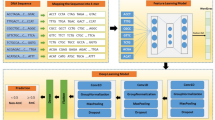Abstract
DNA N6 methyladenine (6mA) is a widely studied and widespread epigenetic modification, which plays a vital role in cell growth and development. 6mA is present in many biological cellular processes, such as the regulation of gene expression and the rule of cross dialogue between transposon and histone modification. Therefore, in some biological research, the prediction of the 6mA site is very significant. Unfortunately, the existing biological experimental methods are expensive both in time and money. And they cannot meet the needs of existing research. So it is high time to develop a targeted and efficient computing model. Consequently, this paper proposes an intelligent and efficient calculation model i6mA-word2vec for the discrimination of 6mA sites. In our work, we use word2vec from the field of natural language processing to carry out distributed feature encoding. The word2vec model automatically represents the target class topic. Then, the extracted feature space was sent into the convolutional neural network as prediction input. The experimental prediction results show that our computational model has better performance.
Access this chapter
Tax calculation will be finalised at checkout
Purchases are for personal use only
Similar content being viewed by others
References
Luo, G.Z., Blanco, M.A., Greer, E.L., et al.: DNA N(6)-methyladenine: a new epigenetic mark in eukaryotes? Nat. Rev. Mol. Cell Biol. 16, 705–710 (2015)
Liu, B., et al.: iRO-3wPseKNC: identify DNA replication origins by three-window-based PseKNC. Bioinformatics 34(18), 3086–3093 (2018). https://doi.org/10.1093/bioinformatics/bty312
Wahab, A., Ali, S.D., Tayara, H., et al.: iIM-CNN: intelligent identifier of 6mA sites on different species by using convolution neural network. IEEE Access 7, 178577–178583 (2019)
Alam, W., Ali, S.D., Tayara, H., et al.: A CNN-based RNA N6-methyladenosine site predictor for multiple species using heterogeneous features representation. IEEE Access 8, 138203–138209 (2020)
Dunn, D.B., Smith, J.D.: Occurrence of a new base in the deoxyribonucleic acid of a strain of bacterium coli. Nature 175, 336–337 (1955)
Vanyushin, B.F., Tkacheva, S.G., Belozersky, A.N.: Rare bases in animal DNA. Nature 225(5236), 948–949 (1970)
Xiao, C.L., Zhu, S., He, M., et al.: N6-methyladenine DNA modification in the human genome. Mol. Cell 71(2), 306–318 (2018)
Chao, Z., Wang, C., Liu, H., et al.: Identification and analysis of adenine N6-methylation sites in the rice genome. Nat. Plants 4, 554–563 (2018)
Pomraning, K.R., Smith, K.M., Freitag, M.: Genome-wide high throughput analysis of DNA methylation in eukaryotes. Methods 47(3), 142–150 (2009)
Krais, A.M., et al.: Genomic N6-methyladenine determination by MEKC with LIF. Electrophoresis 31, 3548–3551 (2010)
Flusberg, B.A., Webster, D.R., Lee, J.H., et al.: Direct detection of DNA methylation during single-molecule, real-time sequencing. Nat. Methods 7(6), 461–465 (2010)
de Araujo Oliveira, J.V., et al.: SnoReport 2.0: new features and a refined Support Vector Machine to improve snoRNA identification. BMC Bioinform. 17(18), 464 (2016)
Gupta, Y., et al.: ptRNApred: computational identification and classification of post-transcriptional RNA. Nucleic Acids Res. 42(22), e167 (2014)
Jana, H., Hofacker, I.L., Stadler, P.F.: SnoReport: computational identification of snoRNAs with unknown targets. Bioinformatics 2, 158–164 (2008)
Song, K.: Recognition of prokaryotic promoters based on a novel variable-window Z-curve method. Nucleic Acids Res. 40(3), 963–971 (2012)
Umarov, R.Kh., Solovyev, V.V.: Recognition of prokaryotic and eukaryotic promoters using convolutional deep learning neural networks. PLoS One 12(2), e0171410 (2017)
Wu, Q., Wang, J., Yan, H.: An improved position weight matrix method based on an entropy measure for the recognition of prokaryotic promoters. Int. J. Data Min. Bioinform. 5(1), 22 (2011)
Chen, W., et al.: iDNA4mC: identifying DNA N4-methylcytosine sites based on nucleotide chemical properties. Bioinformatics 33, 3518–3523 (2017)
He, W., et al.: 4mCPred: machine learning methods for DNA N4-methylcytosine sites prediction. Bioinformatics 35, 593–601 (2018)
Liu, Z., Xiao, X., Qiu, W.R., et al.: IDNA-methyl: identifying DNA methylation sites via pseudo trinucleotide composition. Anal. Biochem. 474, 69 (2015)
Fu, Y., Luo, G.Z., Chen, K., et al.: N6-methyldeoxyadenosine marks active transcription start sites in chlamydomonas. Cell 161(4), 879–892 (2015)
Iyer, L.M., Abhiman, S., Aravind, L.: Natural history of eukaryotic DNA methylation systems. Progress Mol. Biol. Transl. Sci. 101(101), 25–104 (2011)
Chen, W., Lv, H., Nie, F., et al.: i6mA-Pred: identifying DNA N6-methyladenine sites in the rice genome. Bioinformatics 35(11), 2796–2800 (2019)
Huang, Q., Zhang, J., Wei, L., et al.: 6mA-RicePred: a method for identifying DNA N 6-methyladenine sites in the rice genome based on feature fusion. Front. Plant Sci. 11, 4 (2020)
Xu, H., Hu, R., Jia, P., et al.: 6mA-Finder: a novel online tool for predicting DNA N6-methyladenine sites in genomes. Bioinformatics 36(10), 3257–3259 (2020)
Acknowledgments
This work was supported in part by the University Innovation Team Project of Jinan (2019GXRC015), the Natural Science Foundation of Shandong Province, China (Grant No. ZR2021MF036).
Author information
Authors and Affiliations
Corresponding author
Editor information
Editors and Affiliations
Rights and permissions
Copyright information
© 2022 The Author(s), under exclusive license to Springer Nature Switzerland AG
About this paper
Cite this paper
Fu, W., Zhong, Y., Chen, B., Cao, Y., Chen, J., Cong, H. (2022). i6mA-word2vec: A Newly Model Which Used Distributed Features for Predicting DNA N6-Methyladenine Sites in Genomes. In: Huang, DS., Jo, KH., Jing, J., Premaratne, P., Bevilacqua, V., Hussain, A. (eds) Intelligent Computing Theories and Application. ICIC 2022. Lecture Notes in Computer Science, vol 13394. Springer, Cham. https://doi.org/10.1007/978-3-031-13829-4_58
Download citation
DOI: https://doi.org/10.1007/978-3-031-13829-4_58
Published:
Publisher Name: Springer, Cham
Print ISBN: 978-3-031-13828-7
Online ISBN: 978-3-031-13829-4
eBook Packages: Computer ScienceComputer Science (R0)




